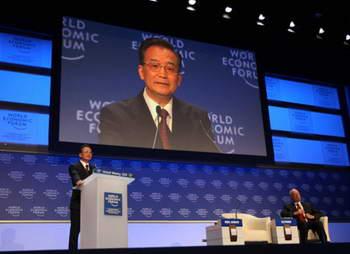China
Full text of Chinese premier´s speech at World Economic Forum Annual Meeting 2009
WATCH VIDEO
Source: Xinhua | 01-29-2009 11:00
Special Report: Premier Wen visits EuropeDAVOS, Switzerland, Jan. 28 (Xinhua) -- The following is the full text of Chinese Premier Wen Jiabao's speech here on Wednesday at the World Economic Forum Annual Meeting 2009.
Watch Video: Part 1 >> Part 2 >>
 |
| Chinese Premier Wen Jiabao speaks at the World Economic Forum annual meeting, in Davos, Switzerland, on Jan. 28, 2009. (Xinhua/Yao Dawei) |
Strengthen Confidence and Work Together for A New Round of World Economic Growth
Special Message by H.E. Wen Jiabao
Premier of the State Council of the People's Republic of China
At the World Economic Forum Annual Meeting 2009
28 January 2009
Professor Klaus Schwab, Executive Chairman of the World Economic Forum, Ladies and Gentlemen,
I am delighted to be here and address the World Economic Forum Annual Meeting 2009. Let me begin by thanking Chairman Schwab for his kind invitation and thoughtful arrangements. This annual meeting has a special significance. Amidst a global financial crisis rarely seen in history, it brings together government leaders, business people, experts and scholars of different countries to jointly explore ways to maintain international financial stability, promote world economic growth and better address global issues. Its theme -- "Shaping the Post-Crisis World" is highly relevant. It reflects the vision of its organizers. People from across the world are eager to hear words of wisdom from here that will give them strength to tide over the crisis. It is thus our responsibility to send to the world a message of confidence, courage and hope. I look forward to a successful meeting.
The ongoing international financial crisis has landed the world economy in the most difficult situation since last century's Great Depression. In the face of the crisis, countries and the international community have taken various measures to address it. These measures have played an important role in boosting confidence, reducing the consequences of the crisis, and forestalling a meltdown of the financial system and a deep global recession. This crisis is attributable to a variety of factors and the major ones are: inappropriate macroeconomic policies of some economies and their unsustainable model of development characterized by prolonged low savings and high consumption; excessive expansion of financial institutions in a blind pursuit of profit; lack of self-discipline among financial institutions and rating agencies and the ensuing distortion of risk information and asset pricing; and the failure of financial supervision and regulation to keep up with financial innovations, which allowed the risks of financial derivatives to build and spread. As the saying goes, "A fall in the pit, a gain in your wit," we must draw lessons from this crisis and address its root causes. In other words, we must strike a balance between savings and consumption, between financial innovation and regulation, and between the financial sector and real economy.
The current crisis has inflicted a rather big impact on China's economy. We are facing severe challenges, including notably shrinking external demand, overcapacity in some sectors, difficult business conditions for enterprises, rising unemployment in urban areas and greater downward pressure on economic growth.
As a big responsible country, China has acted in an active and responsible way during this crisis. We mainly rely on expanding effective domestic demand, particularly consumer demand, to boost economic growth. We have made timely adjustment to the direction of our macroeconomic policy, swiftly adopted a proactive fiscal policy and a moderately easy monetary policy, introduced ten measures to shore up domestic demand and put in place a series of related policies. Together, they make up a systematic and comprehensive package plan aimed at ensuring steady and relatively fast economic growth.
First, substantially increase government spending and implement a structural tax cut. The Chinese Government has rolled out a two-year program involving a total investment of RMB 4 trillion, equivalent to 16 percent of China's GDP in 2007. The investment will mainly go to government-subsidized housing projects, projects concerning the well-being of rural residents, railway construction and other infrastructural projects, environmental protection projects and post-earthquake recovery and reconstruction. Some of them are identified as priority projects in China's 11th Five-Year Plan for Economic and Social Development. The rest are additional ones to meet the needs of the new situation. This two-year stimulus program has gone through scientific feasibility studies and is supported by a detailed financial arrangement. RMB 1.18 trillion will come from central government's budget, which is expected to generate funds from local governments and other sources. The Chinese Government has also launched a massive tax cut program which features the comprehensive transformation of the value-added tax, the adoption of preferential tax policies for small and medium-sized enterprises (SMEs) and real estate transactions, and the abolition or suspension of 100 items of administrative fees. It is expected to bring about a total saving of RMB 500 billion for businesses and households each year.
Second, frequently cut interest rates and increase liquidity in the banking system. The central bank has cut deposit and lending rates of financial institutions five times in a row, with the one-year benchmark deposit and lending rates down by 1.89 percentage points and 2.16 percentage points respectively. Thus the financial burden of companies has been greatly reduced. The required reserve ratio has been lowered four times, adding up to a total reduction of 2 percentage points for large financial institutions and 4 percentage points for small and medium-sized ones. This has released around RMB 800 billion of liquidity and substantially increased funds available to commercial banks. A series of policy measures have been adopted in the financial sector to boost economic growth, including increasing lending, optimizing the credit structure, and providing greater financial support to agriculture and the SMEs.



